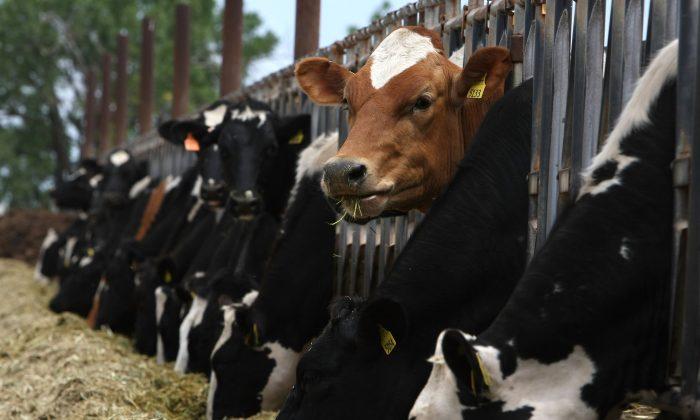It’s a ‘get big or get out’ economy for dairy farmers in America. It is a trend that gives pause as to what our landscapes are becoming, what is happening to the integrity of our dairy supply, and what will become of the sustainable family farm, which has been around since our country was founded.
Due to low prices, farmers have been forced to abandon their dairy farms in droves over the last 20 years as the prevailing economics of the industry have become unsustainable for all but the largest farms. Nationwide, the number of dairy farms has declined by 60 percent, even as total milk production has increased by a third, according to the USDA.
Recent data shows that every day that goes by we lose almost two dairy farms in Wisconsin, and one a week in California, according to Hoard’s Dairyman, a dairy trade publication.
Between 2000 and 2006, the number of farms with less than 200 cows declined by at least 24 percent, and as much as 36 percent. In the same time frame, the number of farms with at least 2,000 cows more than doubled. The largest U.S. dairy farms have over 15,000 cows.

Those that got bigger did so gradually, often by buying up the neighbor’s farms, or through family consolidation. A few were founded by rich investors, particularly large organic dairy farms.
The consolidation created industrial-sized feeding and milking operations that have proven to be unsustainable for the environment, potentially detrimental to human health, and anathema to animal rights advocates.
The industrial farms are part of large cooperatives that have little incentive to pay farmers more than the minimum price set by the government. Some cooperatives will pay even less under certain conditions. The milk produced by this marriage is necessarily the cheapest container on the shelf. Supporters of this system argue that struggling families rely on this low price.
Smaller farms tend to be represented by smaller cooperatives that process and market products directly to the consumer, with a small price premium charged to account for the more labor intensive and sustainable farming practices. These opportunities are still too few and far between for farmers, but they are important.
Westby Cooperative Creamery, founded in 1903, charges an extra 10 percent for products that are guaranteed not to contain recombinant Bovine Growth Hormone, also known as rBGH, which has been linked to lower quality milk.
Hudson Valley Fresh founder Sam Simon founded a small cooperative in Dutchess County, New York, after realizing the plight of farmers. It now has nine farms that follow strict and measurable quality standards, and the brand gets about 80 cents more per half gallon because consumers understand what they are getting. This allows the farmers to be paid a bit more than the cost of production.
Some small farms have found profitable sources of extra income to supplement low milk prices. These include entrepreneurial activities like artisanal cheese production, agritourism, or the breeding and sale of high quality calves.

But probably the most significant bright spots for small, family, dairy farms today is the organic movement, and the organic industry that has been growing by double digits for most of the last 15 years. There are approximately 2,220 organic dairy farms in the country, and most are small farms of less than 200 cows.
The market for organic milk is worth $6 billion dollars, and growing fast. Today it is about 5 percent of total retail milk sales, according to the Organic Trade Association. The fact that consumers of organic milk pay as high as double the conventional price—with a 72 percent markup over the national average, according to the USDA—gives organic dairy farmers more opportunities.
Organic dairy farmers report that they are able to cover their costs with some left over for the kids’ college fund. They are able to farm without using chemical fertilizers, pesticides, or antibiotics, and the milk they produce is the highest quality and safest food on the market.
Unfortunately, the economic lure of going big may upend the lifeline for these small family farmers. When consumers learn that some organic farms use practices that look just like conventional industrial farms, the organic label may lose credibility, and along with it the price premium.
Big or Small, It Matters
At stake is more than just milk. A family farm is a way of life, and an engine of opportunity for rural communities. When farms leave, local communities also disappear, explains Darin Von Ruden, an organic dairy farmer and president of the Wisconsin Farmers Union. When farms close, kids leave, which means schools leave, and then churches leave, and before long everything is gone.
Small farms also spend dollars in the immediate community, which is not the case for large farms, said Von Ruden, who’s family has been farming in Westby, Wisconsin for four generations. The fourth generation is his 22-year-old son, who started managing the farm last year after purchasing the cows and machinery from his dad.
Most dairy farms in this country have been in the family for generations. It really helps to own your land, your barns, and your milking equipment, because affording the upkeep is difficult when milk prices are so low. The market economics today show that the farmer’s share of the retail dairy price has declined from about 52 percent in 1980s to the high 20s today. Farmers frequently complain that buyers are not taking into account the cost to produce milk.
Small farmers are more likely to milk their cows twice a day, morning and evening, which gives the opportunity in the afternoon to release the cows into fields to pasture on nutrient-dense greens like fescue, alfalfa, and clover.
Allowing cows to munch on grass as per their natural inclination is one way small farms save on feed costs, but they also do it because it follows nature’s course. The grazing cows help the farmer harvest the land, and the cows’ manure gives fertilizer for the next crop of grass. It is a virtuous cycle that constantly renews the land.
Large farms operate very differently. The large farm’s methodology is necessarily focused on maximizing profit and efficiency, versus the approach of land stewardship, which is how most small dairy farmers view their work.
In large dairy operations, milk cows generally don’t leave the barn during their production cycle. One farmer explained it’s because the cows are being milked 3 to 4 times a day to maximize production, and so moving thousands of cows out to pasture and back within a window of a few hours is next to impossible.

When the cows are confined it is not long before tonnes of manure piles up and become a problem. A large operation can produce up to 1.6 million tons of manure a year, according to the Government Accountability Office (GAO). That is over four times the weight of the Empire State Building.
This waste is often kept in massive lagoons or sprayed onto fields, according to the Centers for Disease Control, and is susceptible to creating harmful gases that pollute the air, and excessive nutrients that can contaminate soils and fresh water, either through runoff, leaching, or catastrophic spills.
Fifteen government-sponsored or peer-reviewed studies since 2002 have directly linked industrial scale animal agriculture to specific health or environmental impacts, GAO found. The Union of Concerned Scientists has estimated the cost to U.S. taxpayers related to industrial farms to be $30 billion in accumulated pollution costs.
Taxpayers also foot the bill for about $2 billion in subsidies yearly for manure remediation, and $4 billion to subsidize the price of animal feed.
The overwhelming majority of the grain, soy, and corn used for conventional feed is grown using genetically modified seed on monocultures using large amounts of chemical fertilizers, herbicides, pesticides, and fungicides. The toxic runoff from these chemicals is another environmental pollutant.
Overuse of antibiotics, antibiotic residues, and the danger of antibiotic-resistant superbugs are other problems associated with large animal farms, although this is less of a concern for dairy farms. The dairy industry maintains that all milk is tested for antibiotics at the time of sale, and the milk will be rejected by the buyer if it contains any residues.
Antibiotics are used on conventional farms to treat sick animals, three farmers interviewed for this article said, but these animals would be separated from the herd, and milk produced by the sick cows would not be sold.
Nonetheless, some advocates for the organic dairy industry (where the use of antibiotics is against the law), are skeptical of industrial dairy farms. The advocates argue there are so many varieties of antibiotics on the market that it is impossible for every drug to be tested.
Public health advocates quoted by the USDA estimate that 80 percent of the antibiotics sold in the U.S. are used for livestock. The FDA is currently working with the industry to reduce antibiotics use on a voluntary basis.
Understanding Milk Prices
The amount conventional dairy farmers receive for their milk is regulated by the government, as mentioned above, and buyers—the middlemen between the farmers and the consumer—rarely pay more than the minimum. Sometimes farmers are paid less than the minimum, which is not against the law.
Going big is the only way for many dairy farmers to survive in the current system, and the USDA knows this. According to its data, a majority (62.7 percent) of farms are profitable only at herd sizes between 1,000 and 1,999. With herd sizes less than 100, only 6.5 percent of farms are profitable.

The price fluctuates regularly based on factors that most farmers find exceptionally difficult to understand. The price is set by a formula that takes into account the value of the products made from the milk, as well as commodity prices for cheese, dry whey, non-fat dry milk, and butter. The global market only adds to the price instability.
Demand from China for U.S. milk helped prices soar in 2014, but then a decline in China’s economy in 2015 and a ban on U.S. dairy imports into Russia over the Ukraine conflict, led to the current low, where prices are below production costs.
Since the 1930s, there have been numerous schemes and programs to protect farmers from catastrophic price changes, including production limits, export subsidies, and agreements to purchase excess supply, but today there is little of that left.
The 2014 Farm Bill replaced a number of programs with a single margin protection program (MPP) that offers insurance based on the difference between feed costs and milk prices. Farmers also receive tax credits that help with the cost of equipment depreciation, new investments, and manure recovery.
In the last 4–5 years, massive industry consolidation has hit farmers hard. The number of buyers in some parts of the country is down to one or two. In Wisconsin, which has significantly more dairy farms than most other states, Von Ruden has five buyers to choose from for his organic milk.
According to Hoard’s Dairyman, the top 50 dairy co-ops control 78 percent of the nation’s milk. The top five, which includes Dairy Farmers of America, California Dairies, Land O'Lakes, FarmFirst Dairy Cooperative, and Northwest Dairy Association, control 44 percent.
Dairy Farmers of America, which has a partnership with Dean Foods, controls 30 percent of the milk supply. Dean Foods also markets leading processor Land O'Lakes branded cream. With this level of control, farmers in parts of the country, such as in the South Central United States, have only one buyer to take their milk. Dean or Dean.
There have been numerous cries of foul against this arrangement, because Dean Foods can lower the price of milk across the country, according to Von Ruden. Many in the industry believe that the Department of Justice has been lax about antitrust enforcement.
According to Von Ruden, who advocates for a fairer price for farmers, there are many times when the supply and demand mechanism gets pushed past the envelope by large corporate interests who want to see profits for a period of time. He explains how they can turn highly perishable milk into milk powder, or cheese, and stockpile it. Then they can strategically dump it onto the market.
In milk pricing, cheddar cheese is very influential, because daily trades of cheddar on the Chicago Mercantile Exchange figure into the government’s price calculations, and there are very few players who make trades on this market.
Organic Equals Price Stability
The pricing of organic milk is separate from the conventional milk market. While it is also based on supply and demand, organic prices have so far offered much greater stability.
CROPP Cooperative, which is often referred to by its main brand name Organic Valley, is the largest organic dairy cooperative in the country by far, with 1,800 family farm members.
The price Organic Valley farmers earn includes a good profit that allows for generational transfer of the farm, and takes into account the higher cost of organic feed, according to George Siemon, who co-founded CROPP Cooperative in 1988 with the goal of supporting small family farms.
Last year was a good year for organic dairy, and Organic Valley saw sales of just over a billion dollars. This enabled it to pay a “record high pay price to farmers,” according to a company press release.
The coop members received an average of $36.79 per hundredweight, which is the measure for 100 pounds of whole milk used in dairy commodities trading. This represents a 90 percent premium over the average conventional price of $19.38 per hundredweight for the same year. Farmers also got a share of the company’s $36.8 million in profits, a seven point increase over the previous year.
Ruth Buck and her husband are members of Organic Valley, and Buck works part-time for the company as a marketing specialist.

The Buck family used to farm conventionally, but made the transition to organic in order to avoid spraying chemicals on the farm, which Ruth Buck explained she was uncomfortable with, especially around her children. Buck spoke to Epoch Times from her home in Goodhue, Minnesota.
When asked about the economics of organic farming for her family, Buck said the organic price was much more stable than the conventional market, and they have been able to support their six children on the farm income.
When pushed to explain if the price was sufficient for their family, she explained that the farm has the right number of cows (120) for the land (100 acres). “Everything balances out, and you don’t need to push the cows,” she said. At first their banker had pushed them to go bigger, but the couple did not want that.
Von Ruden estimates that beginning organic farmers can earn profits in the 5 to 10 percent range, while established farms could be earning in the 15 to 20 percent range.
Conventional farmers, he said, are earning 1 to 2 percent profit margins or lower. Every five years or so, a good year could yield them 7 to 8 percent.
Siemon said they have been “very fortunate that the organic market has resonated with the consumer,” adding that “it has been a real life saver for dairy farmers.”
He said growth in the variety of dairy products consumers are looking for, such as cheese and yogurt, has helped his company grow.
He also credited the “tremendous push for organics in the retail stores.” Organics are no longer considered a specialty item. They are available in three-quarters of U.S. grocery retailers, according to the USDA’s Economic Research Service.
Industrial Organic

Industrial organic dairy farms are a threat to the prosperity smaller farms are finding with organic, since a single farm can produce more milk than dozens of smaller farms. Located mainly in the West, industrial farms represent 7 percent of organic dairies, but they account for 37 percent of the milk produced, according to the USDA’s Economic Research Service.
Until recently, these farms have been allowed to operate much like conventional farms, the only differences being that the feed was organic, and antibiotics were avoided. It was the same as conventional farms in that the cows were almost always confined in barns, fed grain rather than pasture, and milked 3 or more times a day.
This industrial organic farm’s methodology can yield up to 30 percent higher yields, but the lack of sufficient pasture for animals on these large farms is a hugely contentious issue in the organic community. For most organic farmers, pasture is what defines sustainability and the organic dairy label.
For years, organic farmers and their supporters believed the USDA was failing to enforce the rules of Organic Certification on industrial farms, and they fought for a revision that would make the expectations for pasture more clear.
In 2010 that revision finally came. The rules now say that cows should be on pasture at least 120 days of the year, and obtain at least 30 percent of their diet from pasture grasses.
The revised rule requires much less use of pasture than what most small organic farms regularly use. According to a USDA survey, two-thirds of organic dairies say 50 percent of their feed comes from pasture, and a third say that 75 percent or more comes from pasture.
Siemon, who helped craft the original USDA organic regulations and gave input on the pasture rule revision, said he thought the new rules have made a difference. “Big dairies have a magnifying glass on them,” he said. He also pointed out that they are now doing the “bare bones of grazing,” an improvement on what they had been doing before.
Mark Kastel, co-founder of The Cornucopia Institute, a watchdog on behalf of organic family farmers, expressed skepticism that things had changed since the pasture rule. “There have been some marginal changes,” he said, “zero pasture to token pasture.”
“They [industrial farms] are profiteering by doing everything wrong and putting the organic seal on the product. This is unfair,” said Kastel.
Kastel’s organization uses Freedom of Information requests, interviews with previous farm employees, and aerial flyby photos to check up on farms. When Cornucopia suspects violations, it files complaints with the USDA or takes legal action. It currently has eight lawsuits pending against the USDA.
A few of the people interviewed for this article said it is important to acknowledge that there are a few large farms of up to 1,000 dairy cows that are managed sustainably and ethically. This proves it can be done, they say.

Voting With Our Dollars
Last year was a record year of growth for the organic dairy industry, and keeping up with demand was a problem for producers, according to the Organic Trade Association, but no one is expecting the good times to last.
Growth has “slowed down more than we thought,” said Siemon, explaining that the cooperative is not taking on new farmers right now. “It is critical that you have supply management,” he said.
Von Ruden expressed a concern about instability caused by the global economy, and the pending U.S. election. It costs extra to buy organic, and when people do not know what the country is going to look like in a year, “the consumer begins to question whether they want to spend those dollars or save,” he said.
Jim Ennis, executive director of Catholic Rural Life, said his organization educates its members about the importance of ethical food in agriculture. He pointed out that Americans spend less of their consumer dollar (6.5 percent) on food than anyone else in the world. (The highest spend is in Nigeria, at 56.6 percent, and the middle among a sample of 85 countries is 19.5 percent.)
The conventional farming methods deliver plentiful, cheap food, and with a staple like milk, the price is especially sensitive. These low costs are baked into family’s budgets, and a rise in food prices involves hardship for working and middle class families.
Nonetheless, long-term change in how our food is grown will depend on a continued shift in priorities, as consumers look beyond price to consider the quality and manner of production. This shift in the case of milk could be aided by a change in how the conventional dairy industry is structured, which pushes farmers toward large, industrialized farming.
In Ennis’s view, by treating land like a business, Americans are not valuing it. “But there is a cost to the cheapest food possible,” he said.
Cornucopia has a Dairy Scorecard for consumers who want to know how ethical their brand of milk is. Sixty-eight dairy brands and private label products are rated based on their transparency and adherence to organic standards, and about 20 percent of them scored a substandard rating, according to the report.
Those who scored the highest were farmstead dairies and processors who buy from family farms. These brands are willing to provide the utmost in transparency to their customers.
“We want to help consumers to reward the true heroes in this business,” said Kastel.
CORRECTION: A previous version of this article suggested that the use of antibiotics on large conventional dairy farms is widespread. This is not the case. The Epoch Times regrets the error.







Friends Read Free